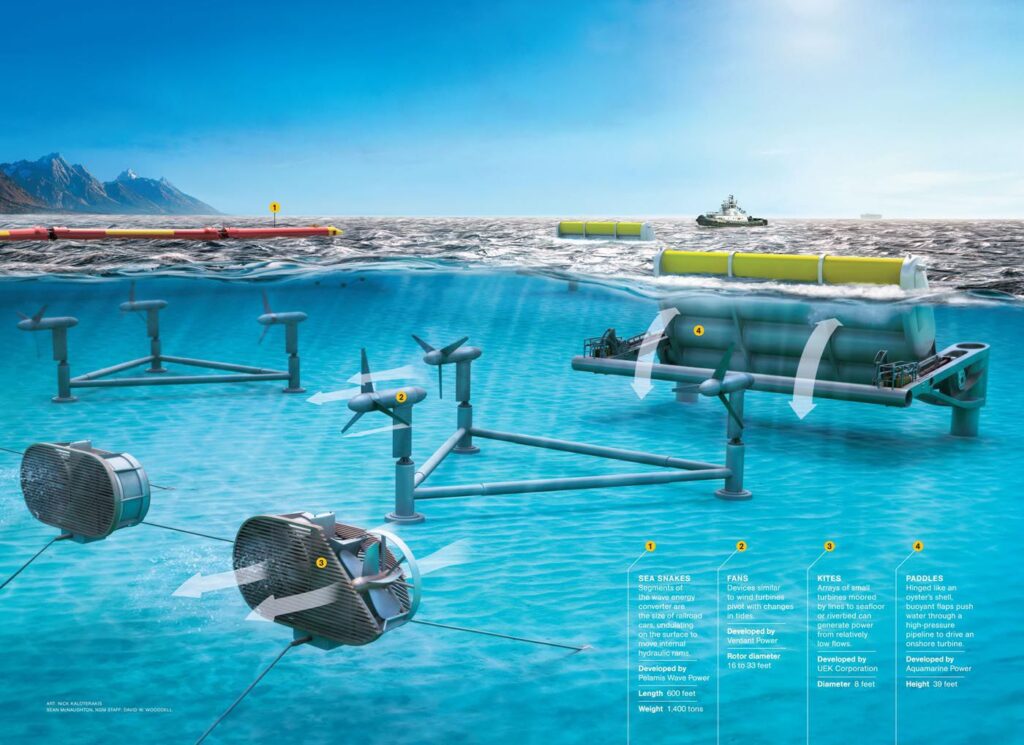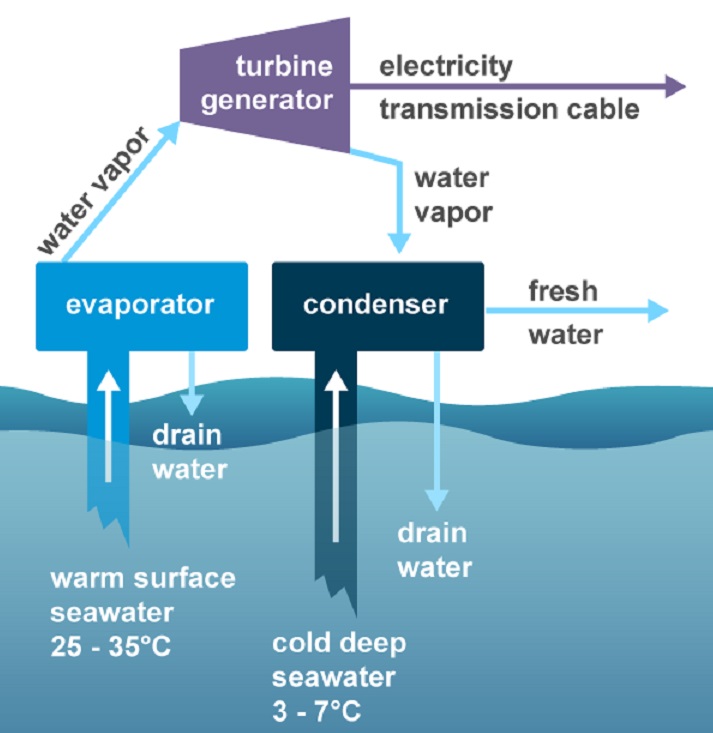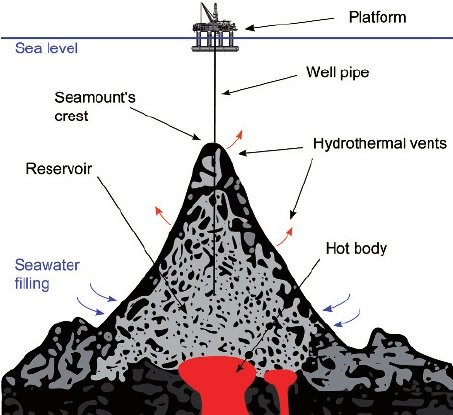Offshore renewable energy installations are increasing across the globe.
Finding renewable energy in lieu of fossil fuels has become a big challenge for the global community. The quest for cheap energy has pushed nations to look towards oceans for alternative sources. Global warming is increasing and could severely imbalance the climate in the coming years. Salvaging the wealth from the sea without disrupting the ecosystem could become a game-changer in the coming decade.
“Earth provides enough to satisfy every man’s needs, but not every man’s greed.”, a quote given by the father of our nation, Mahatma Gandhi almost one century ago, quite true for mankind.
Energy from Oceans and Seas
Exploiting the sea by preserving the marine ecosystem is a sustainable recourse for the growth of blue economy. Apart from fish wealth, oceans can be sourced to meet energy requirements for capacity building. Extending these benefits to the remote island nations would help them to actively participate in providing global energy requirement.
Underwater power cable grids can carry a huge capacilty of energy across the continents and from the different deep-sea energy sources to land. Offshore High Voltage Direct Current (HVDC) cable grids can be laid across the continents and islands for extending the last mile connectivity.
Let us explore the ways we can tap renewable energy from oceans. Since solar farms and wind farms are very common and have been established for years, let us try to focus on other alternative renewable sources. Cost per unit of power being generated can be worked out to ascertain the economic viability of such projects.
Energy from Sea Waves
The waves are generated continuously over the sea surface. Tapping these waves without disturbing the ecosystem is always a challenge to scientists. ARENA (Australian Renewable Energy Agency) under the Government of Australia has made remarkable progress in this area and are currently steering 14 such projects. European Marine Energy Centre (EMEC) Ltd is another leading organisation that has made great progress in tapping sea-wave energy.
The Wave Energy Converter (WEC) is the key building block for taping this energy. There are many types of technology involved in WEC used for tapping the ocean wave energy, a few of them are given below. Deployment of WEC depends on local sea conditions as well as the maximum sea state during adverse weather conditions.
Attenuator : An attenuator is a floating device that operates parallel to the wave direction and effectively rides the waves. These devices capture energy from the relative motion of the two arms as the wave passes them
Absorber : An attenuator is a floating device that operates parallel to the wave direction and effectively rides the waves. These devices capture energy from the relative motion of the two arms as the wave passes them
Oscillating Water Column : An oscillating water column is a partially submerged, hollow structure. It is open to the sea below the waterline, enclosing a column of air on top of a column of water. Waves cause the water column to rise and fall, which in turn compresses and decompresses the air column. This trapped air is allowed to flow to and from the atmosphere via a turbine, which usually has the ability to rotate regardless of the direction of the airflow. The rotation of the turbine is used to generate electricity.
Over-Topping : ‘Over-topping’ has a wave lift over a barrier which fills a reservoir with the water and is then drained through a hydro turbine. This technology is very similar to a conventional hydroelectric power dam.
Inverted-pendulum : Oscillating wave surge converters extract energy from wave surges and the movement of water particles within them. The arm oscillates as a pendulum mounted on a pivoted joint in response to the movement of water in the waves. Inverted-Pendulum device uses the motion of waves to move a hinged paddle back and forth. The motion of the paddle drives hydraulic pumps which drive electrical generators.
Rotating Mass : Two forms of rotation are used to capture energy by the movement of the device heaving and swaying in the waves. This motion drives either an eccentric weight or a gyroscope causes precision. In both cases, the movement is attached to an electric generator inside the device.

Tidal Energy Generation
Tidal energy is renewable energy powered by the natural rise and fall of ocean tides and currents. These technologies include turbines and paddles and are the key element for the generation.
Horizontal axis turbines: Horizontal axis turbines extract energy from moving water in much the same way wind turbines extract energy from moving air. The tidal stream causes the rotors to rotate around the horizontal axis and generate power
Vertical axis turbines: Vertical axis turbines extract energy from the tides in a similar manner mentioned above, however, the turbine is mounted on a vertical axis. The tidal stream causes the rotors to rotate around the vertical axis and generate power.
Hydrofoil : A hydrofoil is attached to an oscillating arm. The tidal current flowing either side of a wing results in lift. This motion then drives fluid in a hydraulic system to be converted into electricity.
Venturi Devices: Venturi Effect devices house the device in a duct that concentrates the tidal flow passing through the turbine. The funnel-like collecting device sits submerged in the tidal current. The flow of water can drive a turbine directly or the induced pressure differential in the system can drive an air turbine.
Archimedes Screw: The Archimedes Screw is a helical corkscrew-shaped device (a helical surface surrounding a central cylindrical shaft). The device draws power from the tidal stream as the water moves up/through the spiral turning the turbines.

Ocean Thermal Energy
Ocean Thermal Energy Conversion (OTEC) is a game-changing technology that leverages the temperature difference in the ocean between cold deep water and warm surface water in the tropics and subtropics to generate unlimited energy. This is ideal for tropical areas/ Indo-Pacific where the temperature difference between deep seawater and surface water is nearing 20 degree Celsius.
Expanding ammonia gas can be used to run the turbine which can be liquefied at high pressures using cool water from the sea bottom. The conversion of liquid ammonia to gas can be done using warm water at the sea surface. Thus there are two heat exchangers in each plant. These plants are ideal for remote islands.

Makai OTEC power plant in the US is the world’s biggest operational facility of its kind with an annual power generation capacity of 100kW, which is sufficient to power 120 homes in Hawaii. The plant is connected to the US grid in 2015. Lockheed Martin is further developing and constructing a 10MW OTEC pilot power plant off the coast of southern China in collaboration with Reign-wood Group. There is a huge possibility for island nations located in the tropical Indo-Pacific region to exploit this technology for power generation.
Energy from Sub Sea Ocean Current
Extracting energy from ocean currents is another difficult task for scientists. Setting up the right turbines underwater is a very cumbersome exercise. Moreover, the ocean currents are at times not predictable. It could change the path. But there are few areas across the ocean where we could get a steady directional current.
A detailed study on ocean current patterns is mandatory prior to the installation of turbines on sea beds. Maintenance and repair of damaged turbines are very difficult. Fish collision and change in ocean currents are the main impediments to the generation of energy from ocean current. There are many suitable sites near Vietnam, Japan, Taiwan, and the Philippines having regions with average current speeds reach 1.0–1.4 m per second.

Offshore Geothermal Energy
Only 20 percent of sea beds have been explored by humans so far. There are many unexplored deep-sea ridges, where thermal energy is available and can be exploited. Sea bed surveillance can be done along the mid-ocean ridges across the oceans to find the sources of geothermal energy. Nutrients and energy supplied by vents support communities of deep-sea organisms that are specific to this environment. By recognising these deep-sea ecosystems, we could easily identify the source of geothermal energy.

A vent is a downward crack in the mid-ocean ridge to depths of 2 to 3 km through the ocean crust where temperature varies from 400–450°C. This super-heated water then re-ascends to the centre of the mid-ocean ridge and emerges as a fast jet at about 350°C. The energy is extracted by pumping cold water to depth using an injection well and then retrieving it at higher temperatures using a production well. At depth, between the wells, water flows through fractures where it is getting heated up. Hot water can be used for generating steam and running turbines.
Floating Solar Farms and Off shore Wind Farms
The solar farm is one of the cheapest and easily implementable solutions on the sea surface. The installation could be undertaken in breakwaters or places where the sea state is low and natural calamities are less. This is very efficient and ideal for tropical sea waters. The disadvantage is that it covers a large area of the sea surface, making it more vulnerable to getting damaged by fishermen folks. Offshore wind farms are the most commonly used renewable source by many nations. Maintenance of these farms has become a little expensive. The associated cables runs of wind farms are prone to damage view fishing activities and anchoring.
Deep Sea HVDC Grid
DC power transmission loss is very less compared to the AC transmission loss. Providing an uninterrupted power supply to small islands from renewable sources remains a challenge for the world. A deep-sea worldwide DC current grid is the best solution towards providing power for remote island nations. DC sea-grids can be coupled to shore grids after converting to an AC source. Power stations could be installed along the coastal belt and small islands.
Conclusion
Energy infrastructures are bound to relocate to oceans in the coming decade. The quest for alternative renewable energy sources is driving nations to sea view constraints in getting space over land. A huge percent of our population stays along the coastal belts and hence could become a direct beneficiary from such projects. In future, HVDC ocean grids across continents and islands will become a reality. Floating renewable energy plants may become more common and can become viable for the sustainable growth of our economy.
Title image courtesy:https://www.boem.gov/renewable-energy/
Disclaimer: The views and opinions expressed by the author do not necessarily reflect the views of the Government of India and Defence Research and Studies
References:
https://arena.gov.au/renewable-energy/ocean/
https://openei.org/wiki/Wave_EnergyAC
http://www.emec.org.uk/marine-energy/wave-devices/
https://www.planete-energies.com/en/medias/close/ocean-current-energy
https://www.reflexorkney.co.uk/
https://www.makai.com/ocean-thermal-energy-conversion/
https://www.thinkgeoenergy.com/green-electricity-from-heat-under-the-sea-offshore-geothermal-energy/








